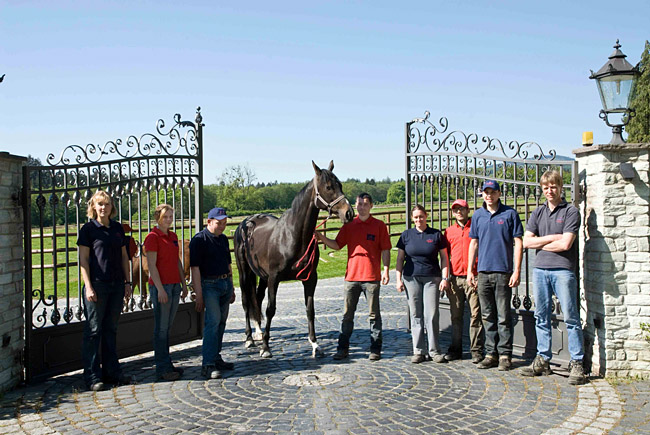At the foot of the Feldberg, directly adjacent to the extensive forest, Bad Homburg’s traditional stud farm, the Gestüt Erlenhof, offers 65 hectares of summer- and winter grazing pastures. Ten champions of the traditional Hamburg Derby – including Ticino, Neckar und Nereide – have enjoyed upbringing under optimal breeding conditions.
The Gestüt Erlenhof’s history dates back to the year 1901 when it was established by Ritter von Marx (the knight von Marx). In 1922 Mr. M.J. Oppenheimer took control of the Gestüt and dedicated it exclusively to the breeding of thoroughbred horses. Only four years later, the Gestüt found a new owner with the steel-baron Heinrich von Tyssen-Bornemisza. In the 50´s, Thyssen-Bornemisza’s sister, the countess Margit Batthyany, devoted herself to the breeding of race horses. Together with Ferdinand Leisten, she was able to maintain and expand the level of athletic and breeding caliber.
In 1977, Hubertus Liebrecht leased the studfarm; he is to thank for forming the remarkable herd of mares, which still provide the basis for current breeding. The death of Liebrecht in 1991 left the future of the Gestüt uncertain.
In 1994 the Rothenberger family took ownership of the complex. The Gestüt’s management remained in the hands of Dr. Jens Freiherr von Lepel until 1997, when he left to the United States to manage a stud farm owned by the descendants of Liebrecht.
Since 1997, the breeding of thoroughbreds has been in the hands of Dr. Stefanie Rothenberger-Krause, while the dressage division is run by Gonnelien and Sven Rothenberger. The success of this cooperative effort has been underlined by the accomplishments of the year 2000. In the spring of 2000 Gonnelien Rothenberger became fith in the Dressage Worldcup Final with her horse Leonardo da Vinci. An Erlenhof-bred horse races in Germany´s most prominent horse race - the Derby in Hamburg - almost every year.
Currently, the herd comprises 14 mares. The Rothenberger family has undertaken the first effort in Germany to combine the breeding of thoroughbreds with dressage. This experiment is represented by the stallions Twen (son of Königsstuhl) and Weyden.
It is the intention to pair mares that have proven successful on the race track with GAG 80 or interesting breeds with international premier stallions. The Erlenhof provides optimal conditions for horsebreeding. 65 hectares of prime grassland are strictly divided into summer and winter paddocks with stringent soil testing performed on an annual basis. The Erlenhof provides room for 110 horses. Approx. 1/3 of the horses are owned by the Gestüt, the rest comprising boarding horses.
In 1994 and 1995 the riding and exercise hall was restored.
In 1996 and 1997 the restoration of the Alte Hengststall (Old Stallion Stables) followed, which now provide housing facilities for the family.
In 1997 and 1998 the Jährlingsstall (Stables for Yearlings) was redone. Next to 8 completely new yearling-boxes, the building includes living quarters for the family and employees.
1999 the renovation of the administration building was undertaken. A new staff room and new sanitary areas were constructed alongside the reinstatement of the building’s “Fachwerk”-facade.
In addition, the renovation of the stables (entailing 21 boxes) at the Braumannswiesen complex aas carried out, which is equipped with a heated self-watering trough (matching the Jährlingsstall). All new stabling was constructed according to the most modern ventilation- and horse-specific standards, with almost all boxes being exterior.
Following an extensive overhaul, the Neue Hengststall (New Stallion Stables) was reopened in December 2000. The building contains 6 large stallion-boxes, a laboratory for frozen- and fresh sperm storage, as well as living quaters for family and personell.
The restoration of the Verwalterhaus and the "Wirtschaftshof" is planned.
The efforts of the last years have been a step towards creating optimal breeding conditions, thus helping to establish the prerequisites for the expansion of horsebreeding activities.




